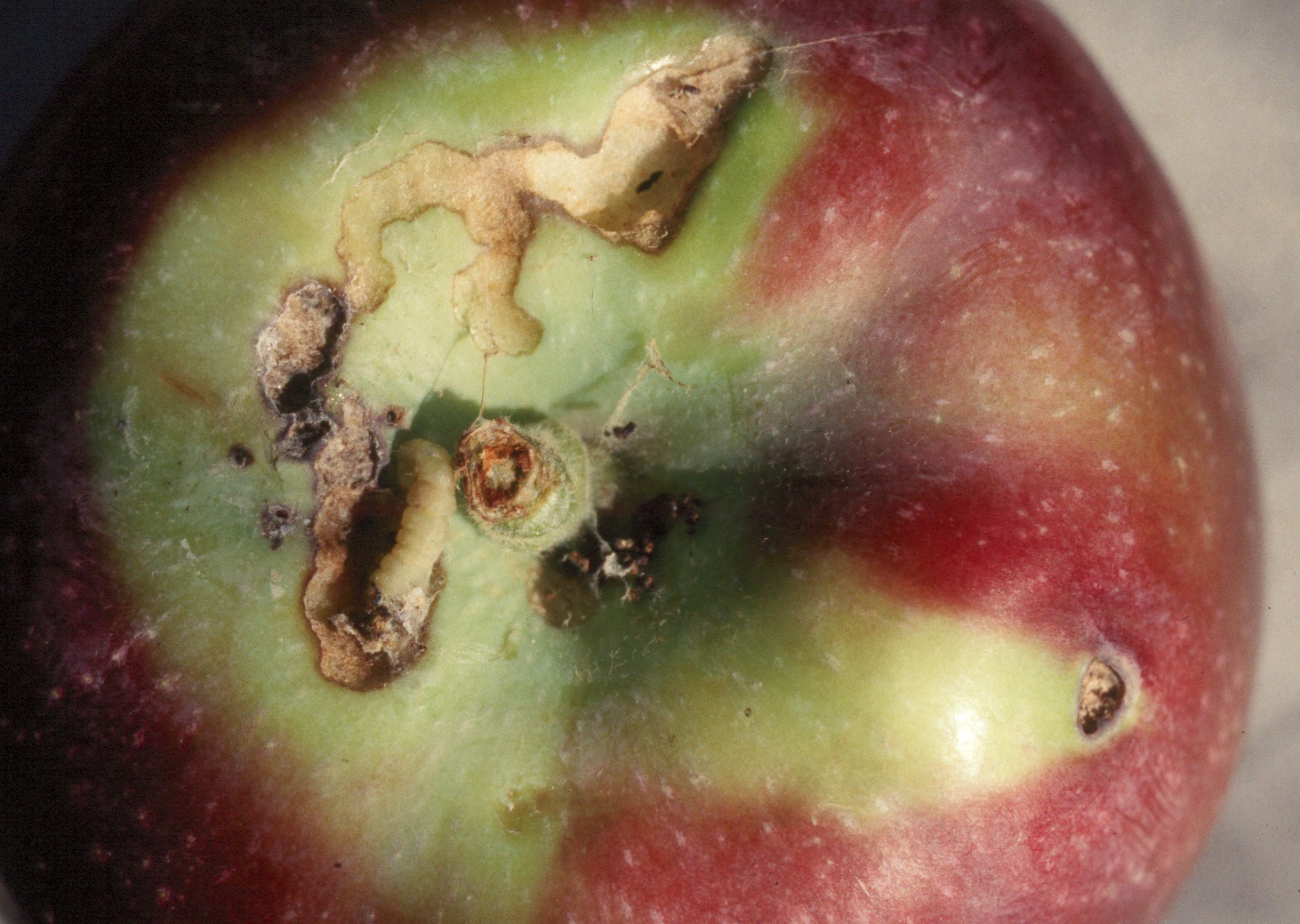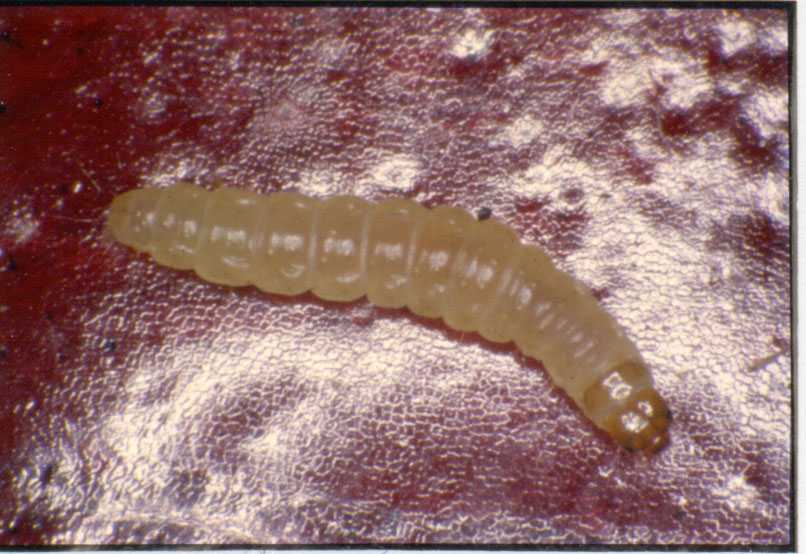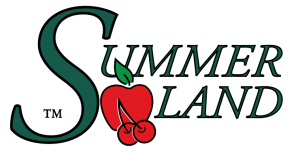Obliquebanded and Threelined Leafrollers
General Description
Hosts
Fruit trees, alder, roses, cottonwood, willow, dogwood, hawthorn, antelope bush, chokecherry, and lupine and other woody wild and landscape ornamentals.
Damage
Buds - Small entry holes in buds, chewed petals and flower parts.
Leaves - Chewed, rolled and tied together with silk.
Fruit - Spring feeding by overwintered larvae causes deep irregular holes in small fruit resulting in large russeted scars in mature fruit. First summer generation larval feeding causes shallow irregular grooves in the fruit skin, often under a leaf tied to fruit or where two fruit are touching (Fig. 1).
 |
| Figure 1. Obliquebanded leafroller feeding damage. (BCMA) |
The second summer generation cause small pin holes which can become infected with rot pathogens leading to storage losses (Fig. 2). This latter damage is difficult to distinguish from that of eyespotted bud moth larvae.
(1).jpg) |
| Figure 2. Late season obliquebanded leafroller feeding damage. (BCMA) |
Identification
Egg - Greenish masses of up to 150 eggs on leaves (Fig. 3).
| Figure 3. Obliquebanded leafroller egg mass laid on a cherry. (H. Philip) |
Larva - Yellowish-green to light green body. Threelined larva has pale green to light tan head (Fig. 4); obliquebanded has brown to black head (Fig. 5).
 |
|
| Figure 4. Obliquebanded leafroller larva. (H. Philip) | Figure 5. Threelined leafroller larva. (BCMA) |
Adult - Obliquebanded moth is about 15 mm long, bell-shaped, brown with alternating light and dark brown transverse bands on the forewings; the threelined moth is about 13 mm long, bell-shaped, pale gray to chocolate brown with alternating white and dark brown transverse bands on the forewings.
Life History
These leafrollers are present throughout the Southern interior and coastal regions. Young larvae overwinter in silken cocoons in bark crevices or under bark scales. Most of the larvae emerge about the 15-mm green bud stage and bore into fruit buds. Some larvae do not emerge until petal-fall. They feed on flower parts, leaves and young fruit. Mature larvae pupate within rolled leaves. Moths of the summer generation emerge from early June to late July. Females lay egg masses on leaves and other objects, and young larvae first feed on terminal growth and may later tie a leaf to a fruit and feed beneath the leaf or between two fruits. Moths of the second generation are active from late August to October and lay eggs on leaves. Larvae hatching from these eggs feed briefly before seeking protected sites on trees in which to overwinter.
Monitoring
Examine fruit bud and blossom clusters for larvae in the spring. In the summer examine terminals and look under leaves attached to fruit for young larvae and feeding damage. Use beating trays to detect the presence of larvae. Pheromone-baited traps are available to monitor adults to establish biofix for the purpose of timing application of sprays such as Confirm and Intrepid against eggs and larvae. There is no relationship between moth captures and subsequent larval abundance or damage.
Management
Biological Control
See the discussion under fruittree and European leafrollers for use of Bacillus thuringiensis (Bt) products Dipel, Foray and Bioprotec for early-season (spring) control of OBLR and TLLR. Some success has been achieved against summer generations using Bt products, especially in cherry blocks within a few days of harvest. Repeat treatments at 7-day intervals may be necessary due to the extended length of time larvae are present.
Cultural Control
It is also important to prune trees to allow thorough penetration and coverage of sprays. Because larvae like to feed where two fruit are in contact, thin fruit to singles where practical. Elimination or spraying of unmanaged host trees next to commercial host crops can help reduce leafroller pressure.
Chemical Control
It is essential to control the spring generation of obliquebanded (OBLR) and threelined (TLLR) leafrollers in order to reduce the need to control the summer generations that are much more difficult to control (increased canopy density, spread out generation time). If no insecticides are applied in the spring or for second generation codling moth, one or more sprays may be needed in July or August against the first summer generation, and possibly in late September to protect the late-maturing fruit from the second summer (overwintering) generation of larvae. An effective spring control program is also necessary if planning to use mating disruption for control of summer generations.
It is also essential that you calibrate and operate your sprayer properly to ensure optimal performance of pest control products. It is important that travel speed allow for sufficient displacement of air from the tree canopy to ensure thorough and uniform spray penetration and coverage.
Spring Control
If significant leafroller damage was evident the previous season or if larval monitoring indicates a potentially serious problem, apply a Bt product (Dipel, Foray 48BA, Bioprotec CAF and Bioprotec PLUS) during bloom and repeat in 7 days if some larvae survived the first spray. Bt will also control any Bruce spanworm, fruitworm and bud moth larvae present. Apply Confirm (maximum 3 applications to apples and pears) or Intrepid (maximum 2 applications, apples only) from late bloom to petal fall to control the spring larval generation. These products will also control other leafroller and bud moth larvae present at the time of application. Because organophosphate-resistant OBLR are also resistant to Confirm and Intrepid, do not apply Confirm or Intrepid if the OBLR population is resistant to organophosphate insecticides (Imidan WP). Thorough coverage is essential for effective control because the larvae must eat Confirm and Intrepid. These products are specific for caterpillars and will not harm beneficial insects and mites. Apply Success or Entrust (maximum 3 applications per season) or Delegate (maximum 3 applications per season), Altacor (maximum 3 applications per season, or 2 applications per season for rates above 215 g/ha), Exirel (maximum 4 applications per year), Danitol (maximum 1 application per season), Vayego 200SC (maximum 3 applications per season), or Harvanta (maximum 3 applications per season) for control of spring OBLR and TLLR on pome and stone fruit. Again thorough and uniform coverage is essential because larvae must eat the product to provide maximum control. These products will also control other leafroller and bud moth larvae present as well as the sap feeder stage of tentiform leafminer. Success and Entrust will also provide control of thrips. Success and Entrust can harm earwigs and parasitic wasps exposed to direct sprays; however the threat is reduced once the residues dry.
Summer Control
Be aware that foliage density and area will be greater than in the spring so make adjustments to sprayer operation to ensure thorough coverage. For suppression of summer generations of leafrollers, apply Confirm (maximum 3 applications, apples and pears only) or Intrepid (maximum 2 applications, apples only) about 10-14 days after biofix and repeat not less than 10-14 days later if necessary. Or, using a degree-day model (base 10°C beginning February 1), once biofix is established, apply Confirm or Intrepid between 120 and 140 DD (corresponds to start of egg hatch) and again between 210 and 240 DD if necessary (corresponds to about 50% egg hatch). Field reports indicate that an application at the second timing is essential for satisfactory reduction of feeding damage, regardless of the timing of the first application. To prevent or delay the development of resistance to Confirm and Intrepid in non-organophosphate resistant leafroller populations, do not apply it against successive generations of leafroller larvae. These products will also aid in control of any exposed codling moth larvae.
Apply Success or Entrust (maximum 3 applications per season) or Delegate (maximum 3 applications per season) or Altacor (maximum 3 applications per season, or 2 applications per season for rates above 215g/ha) or Exirel (maximum 3 applications per season), TwinGuard (maximum 2 applications per season) or Harvanta (maximum 3 applications per season) to all pome and stone fruits or Rimon (maximum 3 applications per season to stone fruits only for control of summer generations of OBLR and TLLR. Again thorough and uniform coverage is essential because the larvae must eat product to provide maximum control. These products will also control any bud moth or other species of leafroller larvae present. Rotate the use of Success or Entrust or Delegate with other control products to prevent or delay the development of resistance. Success Entrust and Delegate can harm earwigs and parasitic wasps exposed to direct sprays; however the threat is reduced once the residues dry. Rimon may be harmful to predatory mites.
Mating disruption
Apply Isomate-CM/LR TT in apples, pears and cherries at a rate of 750 dispensers/ha (300/acre). Double the rate along margins of orchards. Read the general instructions for using mating disruption under Codling Moth. It is important that leafroller population levels are very low within the orchard and there are no nearby outside sources of mated females (e.g. fruit trees, roses, raspberries, cottonwoods, chokecherry, alder, willow, dogwood, big-leaf maple, hawthorn, antelope bush, lupine). This control option also requires effective spring larval control. These products also provide mating disruption of any fruittree leafroller, European leafroller and codling moth male moths present in the treated orchard.
